2011 CHEVROLET CORVETTE traction control
[x] Cancel search: traction controlPage 343 of 428
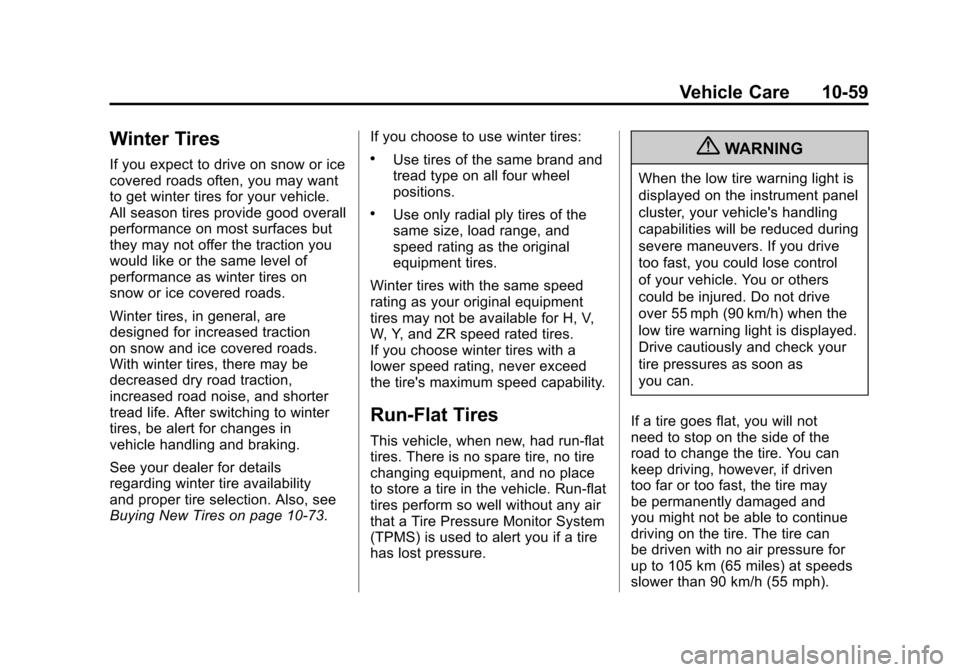
Black plate (59,1)Chevrolet Corvette Owner Manual - 2011
Vehicle Care 10-59
Winter Tires
If you expect to drive on snow or ice
covered roads often, you may want
to get winter tires for your vehicle.
All season tires provide good overall
performance on most surfaces but
they may not offer the traction you
would like or the same level of
performance as winter tires on
snow or ice covered roads.
Winter tires, in general, are
designed for increased traction
on snow and ice covered roads.
With winter tires, there may be
decreased dry road traction,
increased road noise, and shorter
tread life. After switching to winter
tires, be alert for changes in
vehicle handling and braking.
See your dealer for details
regarding winter tire availability
and proper tire selection. Also, see
Buying New Tires on page 10‑73.If you choose to use winter tires:.Use tires of the same brand and
tread type on all four wheel
positions.
.Use only radial ply tires of the
same size, load range, and
speed rating as the original
equipment tires.
Winter tires with the same speed
rating as your original equipment
tires may not be available for H, V,
W, Y, and ZR speed rated tires.
If you choose winter tires with a
lower speed rating, never exceed
the tire's maximum speed capability.
Run-Flat Tires
This vehicle, when new, had run-flat
tires. There is no spare tire, no tire
changing equipment, and no place
to store a tire in the vehicle. Run-flat
tires perform so well without any air
that a Tire Pressure Monitor System
(TPMS) is used to alert you if a tire
has lost pressure.
{WARNING
When the low tire warning light is
displayed on the instrument panel
cluster, your vehicle's handling
capabilities will be reduced during
severe maneuvers. If you drive
too fast, you could lose control
of your vehicle. You or others
could be injured. Do not drive
over 55 mph (90 km/h) when the
low tire warning light is displayed.
Drive cautiously and check your
tire pressures as soon as
you can.
If a tire goes flat, you will not
need to stop on the side of the
road to change the tire. You can
keep driving, however, if driven
too far or too fast, the tire may
be permanently damaged and
you might not be able to continue
driving on the tire. The tire can
be driven with no air pressure for
up to 105 km (65 miles) at speeds
slower than 90 km/h (55 mph).
Page 358 of 428
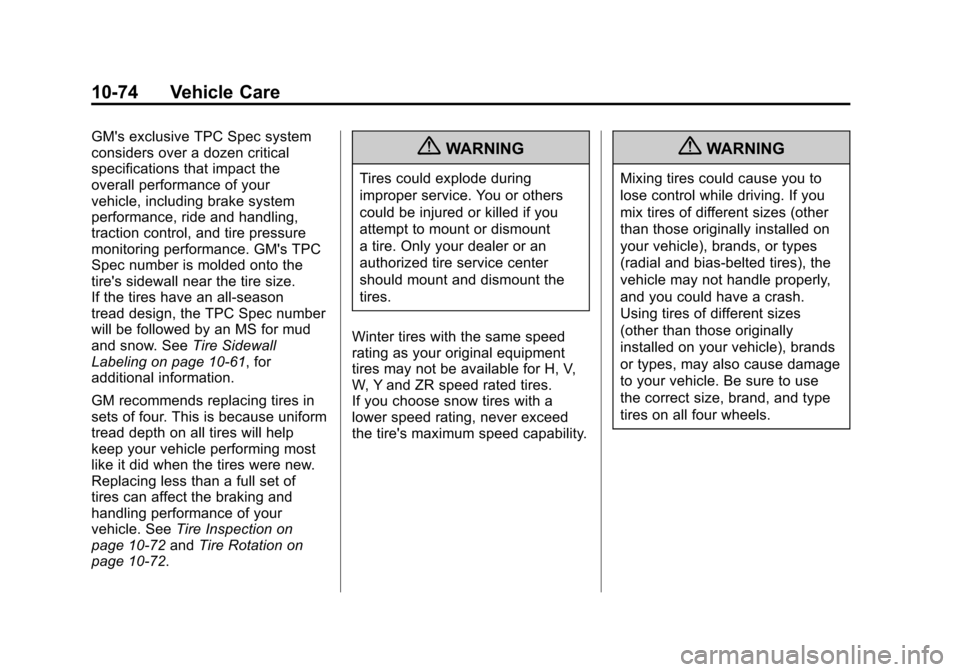
Black plate (74,1)Chevrolet Corvette Owner Manual - 2011
10-74 Vehicle Care
GM's exclusive TPC Spec system
considers over a dozen critical
specifications that impact the
overall performance of your
vehicle, including brake system
performance, ride and handling,
traction control, and tire pressure
monitoring performance. GM's TPC
Spec number is molded onto the
tire's sidewall near the tire size.
If the tires have an all‐season
tread design, the TPC Spec number
will be followed by an MS for mud
and snow. SeeTire Sidewall
Labeling on page 10‑61, for
additional information.
GM recommends replacing tires in
sets of four. This is because uniform
tread depth on all tires will help
keep your vehicle performing most
like it did when the tires were new.
Replacing less than a full set of
tires can affect the braking and
handling performance of your
vehicle. See Tire Inspection on
page 10‑72 andTire Rotation on
page 10‑72.{WARNING
Tires could explode during
improper service. You or others
could be injured or killed if you
attempt to mount or dismount
a tire. Only your dealer or an
authorized tire service center
should mount and dismount the
tires.
Winter tires with the same speed
rating as your original equipment
tires may not be available for H, V,
W, Y and ZR speed rated tires.
If you choose snow tires with a
lower speed rating, never exceed
the tire's maximum speed capability.
{WARNING
Mixing tires could cause you to
lose control while driving. If you
mix tires of different sizes (other
than those originally installed on
your vehicle), brands, or types
(radial and bias-belted tires), the
vehicle may not handle properly,
and you could have a crash.
Using tires of different sizes
(other than those originally
installed on your vehicle), brands
or types, may also cause damage
to your vehicle. Be sure to use
the correct size, brand, and type
tires on all four wheels.
Page 359 of 428
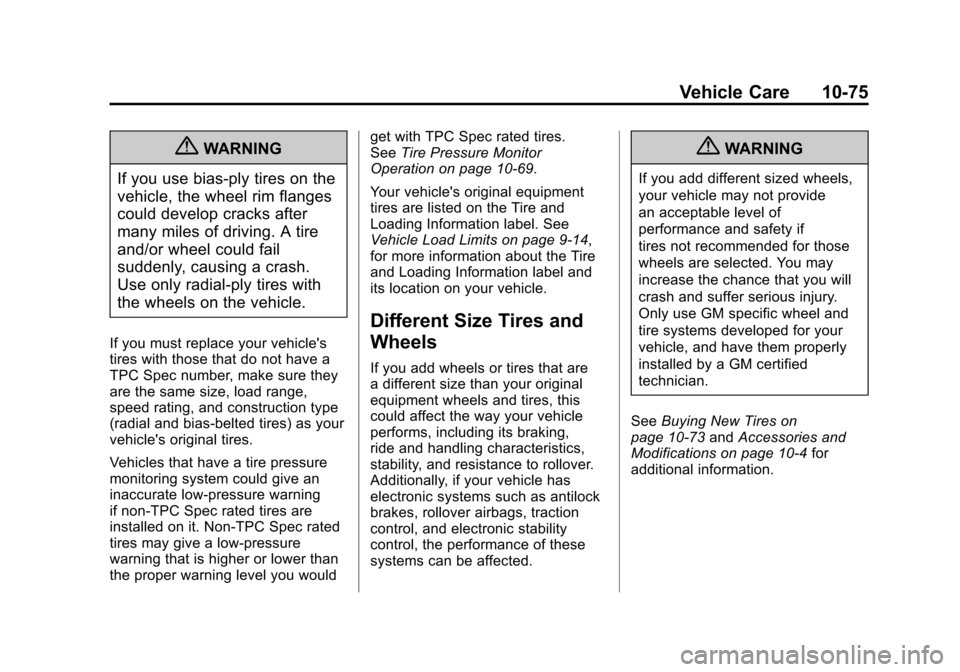
Black plate (75,1)Chevrolet Corvette Owner Manual - 2011
Vehicle Care 10-75
{WARNING
If you use bias-ply tires on the
vehicle, the wheel rim flanges
could develop cracks after
many miles of driving. A tire
and/or wheel could fail
suddenly, causing a crash.
Use only radial-ply tires with
the wheels on the vehicle.
If you must replace your vehicle's
tires with those that do not have a
TPC Spec number, make sure they
are the same size, load range,
speed rating, and construction type
(radial and bias‐belted tires) as your
vehicle's original tires.
Vehicles that have a tire pressure
monitoring system could give an
inaccurate low‐pressure warning
if non‐TPC Spec rated tires are
installed on it. Non‐TPC Spec rated
tires may give a low‐pressure
warning that is higher or lower than
the proper warning level you would get with TPC Spec rated tires.
See
Tire Pressure Monitor
Operation on page 10‑69.
Your vehicle's original equipment
tires are listed on the Tire and
Loading Information label. See
Vehicle Load Limits on page 9‑14,
for more information about the Tire
and Loading Information label and
its location on your vehicle.
Different Size Tires and
Wheels
If you add wheels or tires that are
a different size than your original
equipment wheels and tires, this
could affect the way your vehicle
performs, including its braking,
ride and handling characteristics,
stability, and resistance to rollover.
Additionally, if your vehicle has
electronic systems such as antilock
brakes, rollover airbags, traction
control, and electronic stability
control, the performance of these
systems can be affected.
{WARNING
If you add different sized wheels,
your vehicle may not provide
an acceptable level of
performance and safety if
tires not recommended for those
wheels are selected. You may
increase the chance that you will
crash and suffer serious injury.
Only use GM specific wheel and
tire systems developed for your
vehicle, and have them properly
installed by a GM certified
technician.
See Buying New Tires on
page 10‑73 andAccessories and
Modifications on page 10‑4 for
additional information.
Page 360 of 428
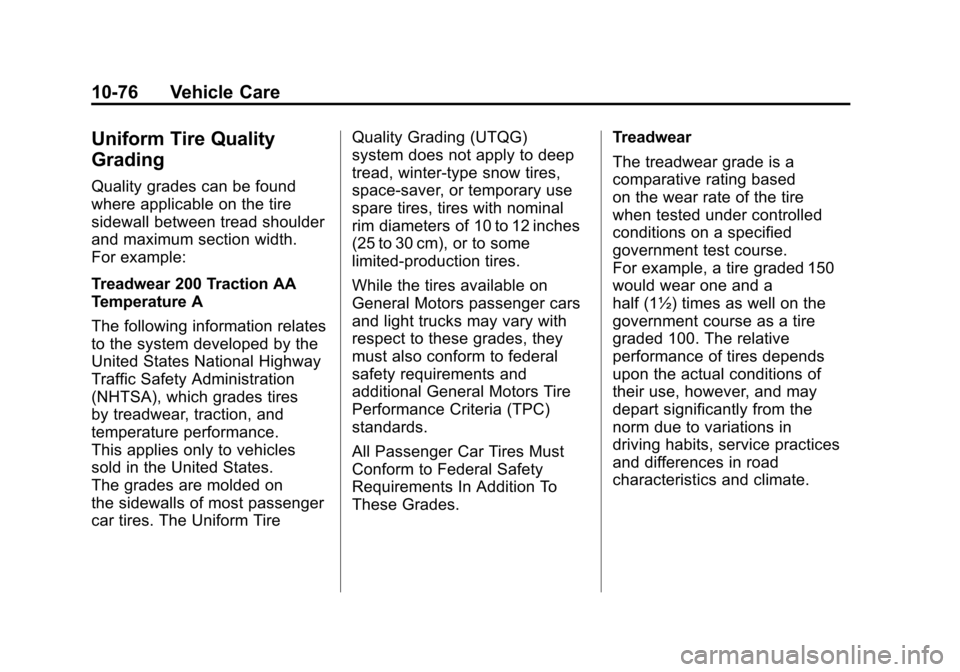
Black plate (76,1)Chevrolet Corvette Owner Manual - 2011
10-76 Vehicle Care
Uniform Tire Quality
Grading
Quality grades can be found
where applicable on the tire
sidewall between tread shoulder
and maximum section width.
For example:
Treadwear 200 Traction AA
Temperature A
The following information relates
to the system developed by the
United States National Highway
Traffic Safety Administration
(NHTSA), which grades tires
by treadwear, traction, and
temperature performance.
This applies only to vehicles
sold in the United States.
The grades are molded on
the sidewalls of most passenger
car tires. The Uniform TireQuality Grading (UTQG)
system does not apply to deep
tread, winter-type snow tires,
space-saver, or temporary use
spare tires, tires with nominal
rim diameters of 10 to 12 inches
(25 to 30 cm), or to some
limited-production tires.
While the tires available on
General Motors passenger cars
and light trucks may vary with
respect to these grades, they
must also conform to federal
safety requirements and
additional General Motors Tire
Performance Criteria (TPC)
standards.
All Passenger Car Tires Must
Conform to Federal Safety
Requirements In Addition To
These Grades.
Treadwear
The treadwear grade is a
comparative rating based
on the wear rate of the tire
when tested under controlled
conditions on a specified
government test course.
For example, a tire graded 150
would wear one and a
half (1½) times as well on the
government course as a tire
graded 100. The relative
performance of tires depends
upon the actual conditions of
their use, however, and may
depart significantly from the
norm due to variations in
driving habits, service practices
and differences in road
characteristics and climate.
Page 361 of 428
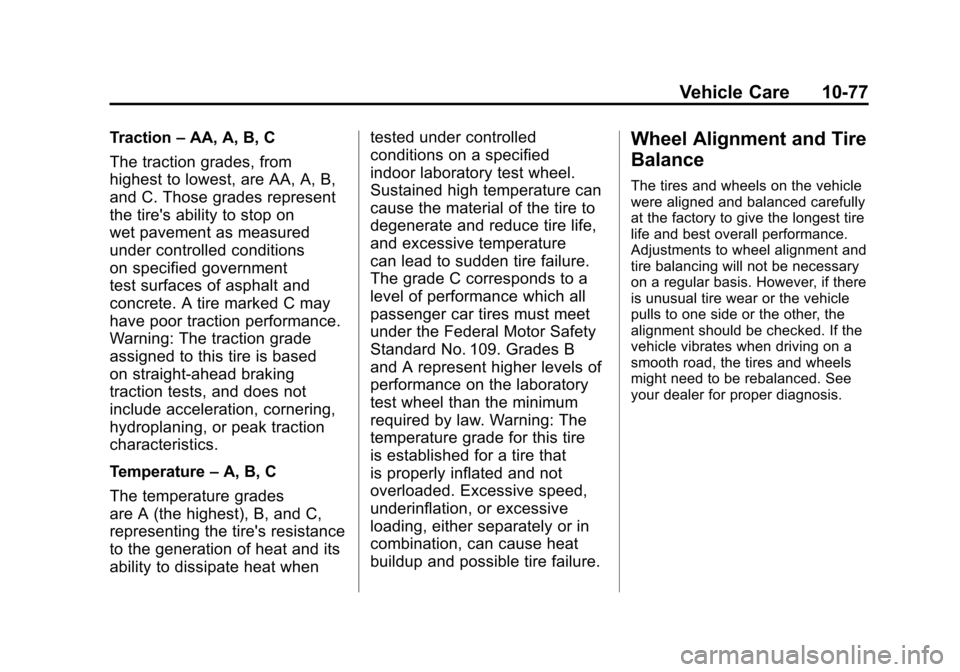
Black plate (77,1)Chevrolet Corvette Owner Manual - 2011
Vehicle Care 10-77
Traction–AA, A, B, C
The traction grades, from
highest to lowest, are AA, A, B,
and C. Those grades represent
the tire's ability to stop on
wet pavement as measured
under controlled conditions
on specified government
test surfaces of asphalt and
concrete. A tire marked C may
have poor traction performance.
Warning: The traction grade
assigned to this tire is based
on straight-ahead braking
traction tests, and does not
include acceleration, cornering,
hydroplaning, or peak traction
characteristics.
Temperature –A, B, C
The temperature grades
are A (the highest), B, and C,
representing the tire's resistance
to the generation of heat and its
ability to dissipate heat when tested under controlled
conditions on a specified
indoor laboratory test wheel.
Sustained high temperature can
cause the material of the tire to
degenerate and reduce tire life,
and excessive temperature
can lead to sudden tire failure.
The grade C corresponds to a
level of performance which all
passenger car tires must meet
under the Federal Motor Safety
Standard No. 109. Grades B
and A represent higher levels of
performance on the laboratory
test wheel than the minimum
required by law. Warning: The
temperature grade for this tire
is established for a tire that
is properly inflated and not
overloaded. Excessive speed,
underinflation, or excessive
loading, either separately or in
combination, can cause heat
buildup and possible tire failure.Wheel Alignment and Tire
Balance
The tires and wheels on the vehicle
were aligned and balanced carefully
at the factory to give the longest tire
life and best overall performance.
Adjustments to wheel alignment and
tire balancing will not be necessary
on a regular basis. However, if there
is unusual tire wear or the vehicle
pulls to one side or the other, the
alignment should be checked. If the
vehicle vibrates when driving on a
smooth road, the tires and wheels
might need to be rebalanced. See
your dealer for proper diagnosis.
Page 364 of 428
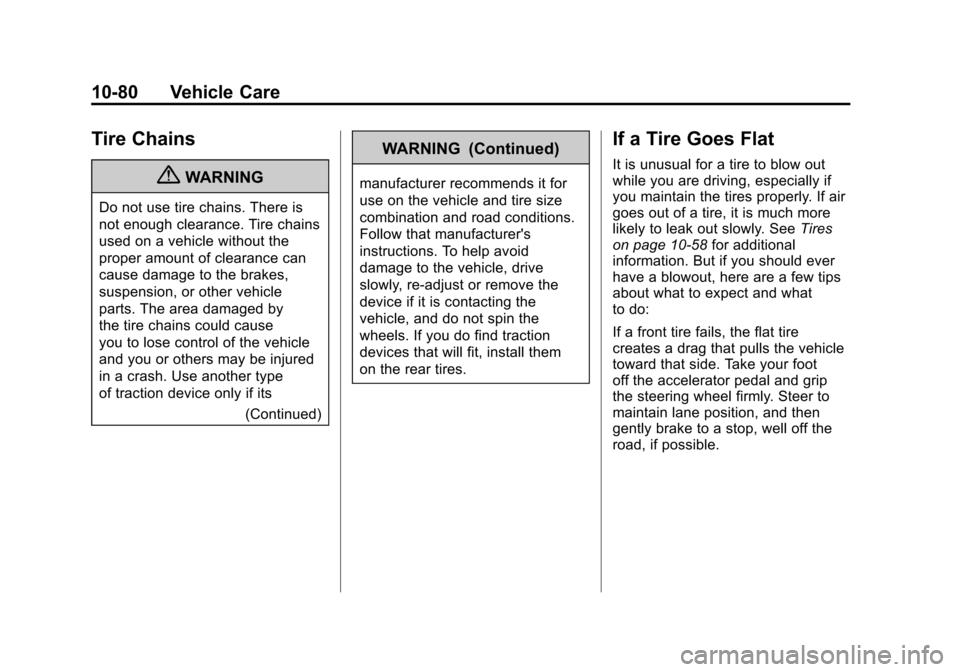
Black plate (80,1)Chevrolet Corvette Owner Manual - 2011
10-80 Vehicle Care
Tire Chains
{WARNING
Do not use tire chains. There is
not enough clearance. Tire chains
used on a vehicle without the
proper amount of clearance can
cause damage to the brakes,
suspension, or other vehicle
parts. The area damaged by
the tire chains could cause
you to lose control of the vehicle
and you or others may be injured
in a crash. Use another type
of traction device only if its(Continued)
WARNING (Continued)
manufacturer recommends it for
use on the vehicle and tire size
combination and road conditions.
Follow that manufacturer's
instructions. To help avoid
damage to the vehicle, drive
slowly, re‐adjust or remove the
device if it is contacting the
vehicle, and do not spin the
wheels. If you do find traction
devices that will fit, install them
on the rear tires.
If a Tire Goes Flat
It is unusual for a tire to blow out
while you are driving, especially if
you maintain the tires properly. If air
goes out of a tire, it is much more
likely to leak out slowly. See Tires
on page 10‑58 for additional
information. But if you should ever
have a blowout, here are a few tips
about what to expect and what
to do:
If a front tire fails, the flat tire
creates a drag that pulls the vehicle
toward that side. Take your foot
off the accelerator pedal and grip
the steering wheel firmly. Steer to
maintain lane position, and then
gently brake to a stop, well off the
road, if possible.
Page 423 of 428

Black plate (7,1)Chevrolet Corvette Owner Manual - 2011
INDEX i-7
Lights (cont.)Front Fog Lamps . . . . . . . . . . . . . 5-25
High-Beam On . . . . . . . . . . . . . . . . 5-25
High/Low Beam Changer . . . . . . 6-2
One-to-Four Shift . . . . . . . . . . . . . 5-22
Safety Belt Reminders . . . . . . . . 5-16
Security . . . . . . . . . . . . . . . . . . . . . . 5-24
Tire Pressure . . . . . . . . . . . . . . . . . 5-24
Traction Control System
(TCS) Warning . . . . . . . . . . . . . . 5-23
Limited-Slip Rear Axle . . . . . . . . . 9-42
Locks Automatic Door . . . . . . . . . . . . . . . 2-10
Door . . . . . . . . . . . . . . . . . . . . . . . . . . . 2-8
Lockout Protection . . . . . . . . . . . . 2-10
Power Door . . . . . . . . . . . . . . . . . . . . 2-9
Loss of Control . . . . . . . . . . . . . . . . . 9-6
Low-Profile Tires . . . . . . . . . . . . . . 10-60
Lower Anchors and Tethers for Children
(LATCH SYSTEM) . . . . . 3-43, 3-44
Lumbar Adjustment . . . . . . . . . . . . . 3-6 Front Seats . . . . . . . . . . . . . . . . . . . . 3-6M
Maintenance
Records . . . . . . . . . . . . . . . . . . . . . . 11-9
Maintenance Schedule Recommended Fluids andLubricants . . . . . . . . . . . . . . . . . . . 11-6
Scheduled Maintenance . . . . . . 11-2
Malfunction Indicator Lamp . . . . 5-18
Manual Mode . . . . . . . . . . . . . . . . . . 9-29
Manual Transmission . . . . . . . . . . 9-32 Fluid . . . . . . . . . . . . . . . . . . . . . . . . 10-23
Memory Features . . . . . . . . . . . . . . . 1-8
Messages Anti-Theft Alarm System . . . . . . 5-50
Battery Voltage andCharging . . . . . . . . . . . . . . . . . . . . 5-35
Brake System . . . . . . . . . . . . . . . . 5-36
Convertible Top . . . . . . . . . . . . . . . 5-37
Door Ajar . . . . . . . . . . . . . . . . . . . . . 5-39
Engine Cooling System . . . . . . . 5-39
Engine Oil . . . . . . . . . . . . . . . . . . . . 5-40
Engine Power . . . . . . . . . . . . . . . . 5-41 Messages (cont.)
Fuel System . . . . . . . . . . . . . . . . . . 5-41
Key and Lock . . . . . . . . . . . . . . . . . 5-42
Lamp . . . . . . . . . . . . . . . . . . . . . . . . . 5-44
Ride Control System . . . . . . . . . . 5-44
Safety Belt . . . . . . . . . . . . . . . . . . . . 5-49
Service Vehicle . . . . . . . . . . . . . . . 5-50
Starting the Vehicle . . . . . . . . . . . 5-50
Tire . . . . . . . . . . . . . . . . . . . . . . . . . . . 5-51
Transmission . . . . . . . . . . . . . . . . . 5-53
Vehicle . . . . . . . . . . . . . . . . . . . . . . . 5-35
Vehicle Reminder . . . . . . . . . . . . . 5-54
Washer Fluid . . . . . . . . . . . . . . . . . 5-54
Mirrors
Automatic Dimming . . . . . . . . . . . 2-16
Automatic DimmingRearview . . . . . . . . . . . . . . . . . . . . 2-16
Convex . . . . . . . . . . . . . . . . . . . . . . . 2-15
Folding . . . . . . . . . . . . . . . . . . . . . . . 2-16
Heated . . . . . . . . . . . . . . . . . . . . . . . 2-16
Power . . . . . . . . . . . . . . . . . . . . . . . . 2-15
Monitor System, Tire Pressure . . . . . . . . . . . . . . . . . . . . 10-68
Page 427 of 428

Black plate (11,1)Chevrolet Corvette Owner Manual - 2011
INDEX i-11
T
Tachometer . . . . . . . . . . . . . . . . . . . . 5-11
TaillampsTurn Signal, andStoplamps . . . . . . . . . . . . . . . . 10-50
Text Telephone (TTY) Users . . . 13-6
Theft-Deterrent Systems . . . . . . . 2-14 Immobilizer . . . . . . . . . . . . . . . . . . . 2-14
Time . . . . . . . . . . . . . . . . . . . . . . . . . . . . 5-6
Tires Buying New Tires . . . . . . . . . . . 10-73
Chains . . . . . . . . . . . . . . . . . . . . . . 10-80
Designations . . . . . . . . . . . . . . . 10-62
Different Size . . . . . . . . . . . . . . . 10-75
If a Tire Goes Flat . . . . . . . . . . 10-80
Inflation Monitor System . . . . 10-69
Inspection . . . . . . . . . . . . . . . . . . 10-72
Lifting the Vehicle . . . . . . . . . . . . . 10-5
Low Profile . . . . . . . . . . . . . . . . . 10-60
Messages . . . . . . . . . . . . . . . . . . . . 5-51
Pressure . . . . . . . . . . . . . . . . . . . . 10-67
Pressure Light . . . . . . . . . . . . . . . . 5-24
Pressure Monitor System . . . 10-68 Tires (cont.)
Rotation . . . . . . . . . . . . . . . . . . . . 10-72
Run-Flat . . . . . . . . . . . . . . . . . . . . 10-59
Sidewall Labeling . . . . . . . . . . . 10-61
Terminology and
Definitions . . . . . . . . . . . . . . . . . 10-63
Uniform Tire Quality Grading . . . . . . . . . . . . . . . . . . . 10-76
Wheel Alignment and Tire
Balance . . . . . . . . . . . . . . . . . . . 10-77
Wheel Replacement . . . . . . . . 10-78
When It Is Time for New Tires . . . . . . . . . . . . . . . . . . . . . . 10-72
Winter . . . . . . . . . . . . . . . . . . . . . . 10-59
Towing General Information . . . . . . . . . . 9-54
Recreational Vehicle . . . . . . . . 10-86
Vehicle . . . . . . . . . . . . . . . . . . . . . 10-86
Traction Active Handling System . . . . . . 9-37
Control System (TCS) . . . . . . . . 9-36
Control System WarningLight . . . . . . . . . . . . . . . . . . . . . . . . 5-23
Limited-Slip Rear Axle . . . . . . . . 9-42
Selective Ride Control . . . . . . . . 9-42 Transmission
Automatic . . . . . . . . . . . . . . . . . . . . . 9-28
Fluid, Automatic . . . . . . . . . . . . 10-23
Fluid, Manual . . . . . . . . . . . . . . . 10-23
Messages . . . . . . . . . . . . . . . . . . . . 5-53
One-to-Four Shift Light . . . . . . . 5-22
Transportation Program,
Courtesy . . . . . . . . . . . . . . . . . . . . 13-10
Turn and Lane-Change Signals . . . . . . . . . . . . . . . . . . . . . . . . 6-4
Twilight Sentinel . . . . . . . . . . . . . . . . 6-3
U
Uniform Tire Quality
Grading . . . . . . . . . . . . . . . . . . . . . 10-76
Universal Remote System . . . . . 5-64 Operation . . . . . . . . . . . . . . . . . . . . . 5-69
Programming . . . . . . . . . . . . . . . . . 5-64
Using this Manual . . . . . . . . . . . . . . . . iv